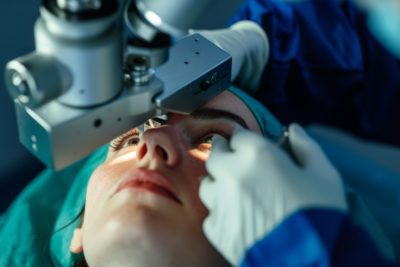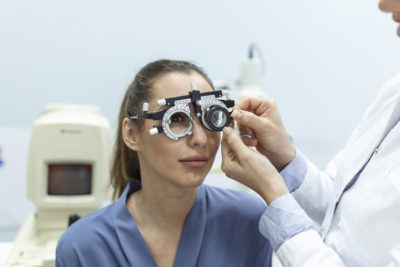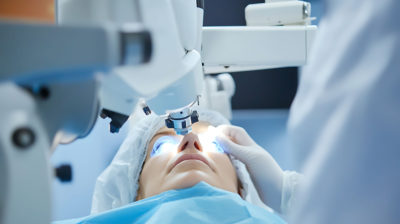Presbyopia is a common age-related vision condition that affects individuals typically after the age of 40. It is characterised by the gradual loss of the eye’s ability to focus on nearby objects due to the natural ageing process of the crystalline lens. As technology continues to advance, new and innovative treatments emerge to address age-related vision issues. One such groundbreaking solution is PresbyLASIK, an advanced laser vision correction technique specifically designed for the treatment of presbyopia.
Understanding Presbyopia
Before delving into the intricacies of PresbyLASIK, it is essential to comprehend the nature of presbyopia. The crystalline lens, located inside the eye, loses its flexibility with age, making it challenging for the eye to focus on close objects. Common symptoms include difficulty reading small print, eyestrain, and the need for brighter lighting when engaging in close-up tasks.
Traditional Solutions for Presbyopia
Historically, individuals with presbyopia turned to reading glasses or bifocals to address the challenges associated with near vision. While these solutions are effective, they do not provide a permanent fix and can be inconvenient for those who wish to maintain an active lifestyle without the hassle of constantly carrying and switching between different pairs of glasses.
LASIK Surgery – An Overview
Laser-Assisted In Situ Keratomileusis, is a popular surgical procedure used to correct common vision problems such as nearsightedness (myopia), farsightedness (hyperopia), and astigmatism. LASIK surgery is designed to reshape the cornea, the transparent front part of the eye, in order to improve how the eye focuses light onto the retina.
Here’s an overview of the LASIK procedure:
-
Corneal Flap Creation: The surgeon uses a microkeratome or a femtosecond laser to create a thin flap in the cornea. This flap is gently lifted, exposing the underlying corneal tissue.
-
Laser Reshaping: An excimer laser is employed to precisely remove a predetermined amount of corneal tissue based on the patient’s prescription. For nearsighted individuals, the cornea is flattened, while for farsighted individuals, it is made steeper. Astigmatism can also be corrected by smoothing irregularities in the cornea.
-
Flap Repositioning: After the laser reshaping is complete, the corneal flap is carefully repositioned. It begins to adhere on its own without the need for stitches.
LASIK surgery is known for its quick recovery time and often allows patients to achieve improved vision almost immediately or within a day or two. It is considered a relatively safe and effective procedure for individuals with stable vision prescriptions and overall good eye health.
While LASIK has a high success rate, it’s important for individuals considering the surgery to undergo a thorough eye examination to determine if they are suitable candidates. Not everyone is eligible for LASIK, and factors such as age, eye health, and medical history play a role in determining candidacy. Consulting with an experienced eye surgeon is crucial for understanding the potential risks and benefits of LASIK surgery.
The Emergence of PresbyLASIK
PresbyLASIK, short for Presbyopic Laser-Assisted In Situ Keratomileusis, represents a significant leap forward in the field of vision correction. This advanced laser eye surgery is specifically tailored to address presbyopia by reshaping the cornea, the transparent front part of the eye, to enhance its ability to focus on both near and distant objects.
How PresbyLASIK Works
PresbyLASIK involves the use of a highly precise laser to reshape the cornea, correcting the refractive errors that contribute to presbyopia. The procedure typically employs a combination of techniques, such as monovision or multifocal ablation, to optimise vision at different distances. Monovision involves adjusting one eye for distance vision and the other for near vision, allowing the brain to adapt and seamlessly integrate both perspectives.
Patient Eligibility and Screening
Not everyone is an ideal candidate for PresbyLASIK, and thorough screening is essential to determine suitability. Factors such as overall eye health, corneal thickness, and the presence of other eye conditions are carefully evaluated by ophthalmologists during the preoperative assessment. Additionally, the patient’s expectations and lifestyle are considered to ensure realistic outcomes and satisfaction post-surgery.
Benefits of PresbyLASIK
PresbyLASIK offers several advantages over traditional presbyopia treatments:
Reduced Dependence on Glasses:
-
One of the primary benefits is a significant reduction in the need for reading glasses or bifocals after the surgery.
Improved Quality of Vision:
-
Many patients report an enhancement in the quality of their vision, experiencing clearer and sharper focus at various distances.
Quick Recovery:
The recovery period for PresbyLASIK is generally rapid, with most patients experiencing improved vision within a few days.
Long-lasting Results:
Unlike some temporary solutions, PresbyLASIK provides lasting results, offering a more permanent fix for presbyopia.
Customisation for Individual Needs:
The procedure can be customised to meet the specific visual needs and lifestyle of each patient, ensuring a personalised approach to vision correction.
Potential Risks and Considerations
While PresbyLASIK has proven to be a safe and effective procedure for many, it is not without potential risks. Like any surgery, there is a possibility of complications, such as dry eyes, glare, or halos around lights. It is crucial for individuals considering PresbyLASIK to thoroughly discuss the procedure, potential risks, and expected outcomes with their ophthalmologist to make an informed decision.
PresbyLASIK represents a remarkable advancement in the field of laser vision correction, offering a tailored solution for individuals grappling with presbyopia. As technology continues to evolve, it is likely that further refinements and innovations will emerge in the realm of vision correction, providing even more options for those seeking to enhance and preserve their eyesight as they age. If you are considering PresbyLASIK, consulting with a qualified eye care professional is essential to determine whether this procedure is the right choice for your individual needs and circumstances.
Experience the pinnacle of vision correction with PresbyLASIK at Dr Agarwals Eye Hospital, renowned for its commitment to excellence. With state-of-the-art technology and personalised procedures, Dr Agarwals Eye Hospital provides a proven track record of successful PresbyLASIK outcomes. Trust our patient-centric approach, where your comfort, safety, and long-term eye health are our priorities. Say goodbye to the limitations of presbyopia and embrace a life of clear vision. Schedule your consultation today at Dr Agarwals Eye Hospital and step into a brighter, glasses-free future.








